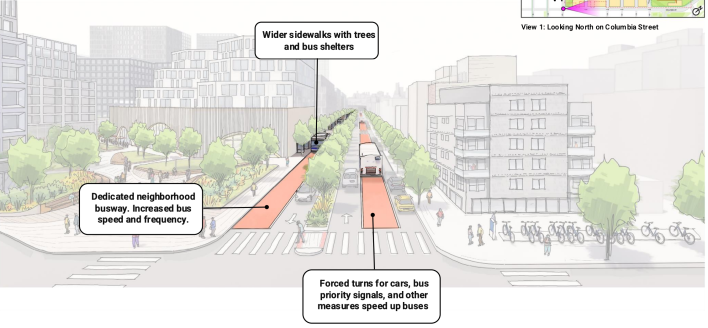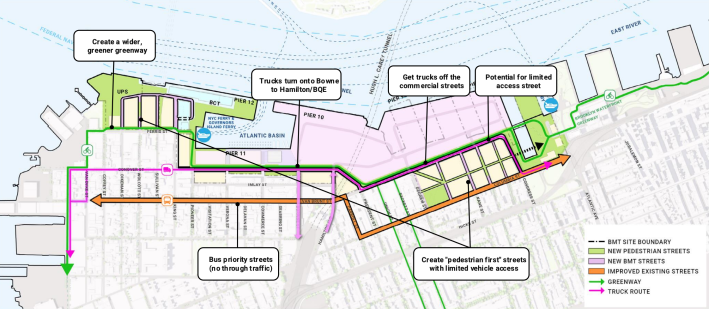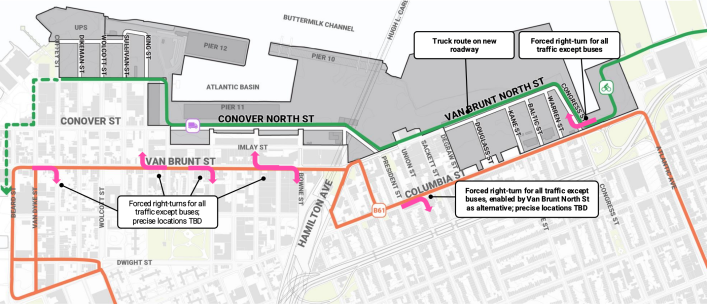The 122-acre Brooklyn Marine Terminal campus could be New York City's newest "pedestrian-oriented" neighborhood as the city prepares for 8,000 new housing apartments on the site, officials said.
The city's massive redevelopment may include upgrades to buses, ferries, and bike lanes, according to the preliminary proposals to an advisory group shared exclusively with Streetsblog by the city's Economic Development Corporation [PDF].
"The transformation of the Brooklyn Marine Terminal into a world-class, modern maritime port and vibrant mixed-use community is a generational moment for New York City — an opportunity to truly think big," EDC spokesperson Jeff Holmes in a statement. (EDC is a city-owned public-benefit corporation.)
Locals and experts agree that the city must think big to manage the transportation needs of the influx of newcomers. Nearby residential areas hemmed in by the Brooklyn-Queens Expressway have suffered from a haphazard transportation network thanks to no direct subway access.
Trucks from last-mile warehouses inundate the waterfront, while smoke-belching mega-cruise liners regularly dump passengers into hundreds of rideshare vehicles bound for Manhattan. Citi Bike docks are also routinely at capacity, stranding residents and visitors.
The EDC's proposals are quite preliminary, but they include doubling frequency on the (slow) B61 bus and adding bus lanes on Columbia and Van Brunt streets, possibly in the form of a "neighborhood busway." That would restrict through-traffic for private vehicles as the city has done on the Fulton Mall, Jay Street, and 14th Street in Manhattan.

The proposal calls for east-west shuttles to bring residents from the new developments directly to the closest subway stations on the F and G lines in Gowanus, Carroll Gardens and Cobble Hill, though such shuttles would likely only serve the newcomers (EDC said it would study the "feasibility" of additional stops in the mostly hard-scrabble neighborhood). A "pilot bus service" through the Hugh Carey Tunnel to Manhattan, which is less than two miles away across the river, is also on the table.
Locals have repeatedly pushed for a bus across the river; MTA leaders have recently said they're open to the idea.

EDC committed "up to $25 million" for electric shuttles. Most other proposals would require work from the city Department of Transportation and buy-in from the state-run Metropolitan Transportation Authority.
The pedestrian-centered areas would have limited access to vehicles and cover a section at the north end of the redevelopment, west of Columbia Street north of Degraw, and south of Atlantic Basin west of Ferris Street. The new areas would be similar to industrial redevelopments into livable communities like Nordhavn in Copenhagen, or Västra Hamnen in Malmö, officials said.
A wider and expanded greenway would close a network gap in Red Hook by running through the roads that currently are inside the port area.
The plans so far primarily serve the new developments, according to one member of the redevelopment's task force, which includes elected officials, community groups, business reps and transportation experts who will vote on the proposals in mid-June.
"You’ve got 16,000 [new] people, you can do some basic math … and understand that doubling the B61 and these shuttles is not going to get us there from a numbers perspective," said Carly Baker-Rice a program manager at the Red Hook Business Alliance. "They’re trying to put a lot of rosy stuff on it, but it certainly doesn’t serve the existing population."
The city will have to make sure drivers don't keep hogging the streets, according to one transportation expert and felllow member of the task force.
"I’m concerned about the reality of enforcement with that," said Tiffany-Ann Taylor, vice president for transportation at the Regional Plan Association. "I am still concerned that people will just pay that fine and break that regulation."
Taylor cited the city's Stipulated Fine Program, which gives delivery companies a discount on parking tickets in exchange for them not contesting the violations — essentially letting businesses eat the tickets as a cost of doing business.
The EDC's plans also propose diverting truck traffic off the main streets to new roads currently inside the port, and directly onto the BQE at Hamilton Avenue, while building out paths for smaller delivery vehicles like cargo e-bikes.

Cargo e-bikes have already deployed en masse from the Amazon warehouses, as a recent video of an e-bike convoy on the greenway along Columbia Street makes abundantly clear.
The truck diversions could still backfire if heavy haulers bottleneck again at both ends, blocking buses going onto Atlantic Avenue, Baker-Rice noted.
"You might be traveling faster on those roads for a few blocks, but you hit the same problems at the end," she said.
EDC officials previously said more deliveries could also divert from trucks to barges, via so-called blue highways, but it's unclear how quickly this shift to the waterways will happen.
The other big elephant in the room is what will happen with the BQE, which is currently in limbo as the city looks to secure funding from Washington, D.C. for a reconstruction of the crumbling triple-cantilever around Brooklyn Heights.
DOT is considering closing the chaotic Atlantic Avenue on-ramp to the BQE, which could discourage the current cut-through traffic Columbia Street, Hicks Street and Clinton Street.
"Even though you have the best ideas in the world, you still have this highway three blocks away that directly impacts the traffic," Taylor said.






